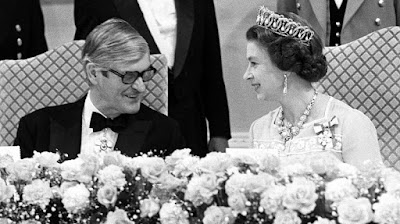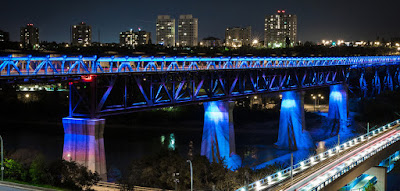From the big scrapbook of time, here’s a look at Canada in 1913-
 |
| Kam, Klik and Holiday Loaf will be popular products from Burns. The meat packer will be bought by Maple Leaf in 1996. |
January 12: Despite the heroic efforts of firemen, flames consume the P. Burns & Company meat packing plant in Calgary. Damage is estimated to be in excess of $2 million.
January 14: The assets of the Harding Motor Car Company of London, Ontario are liquidated for $24,000. The $750 price tag for the four-cylinder car with the sliding transmission didn’t find enough takers. Fred Harding, the owner, will die in a few months.
 |
| The official crest of the Nisga'a Nation. |
January 22: The Nisga'a Indians of British Columbia defiantly announce they own the Nass River Valley. Their spokesman disputes Victoria’s claim that the tribe signed a treaty with the Crown, giving away their land. The dispute will be resolved in 2000.
 |
| The HMS Naiobe began service in 1898. |
January 24: The nation’s first naval cadets graduate from the Halifax Naval College. Cadets trained on the HMCS Niobe, a ship purchased from Britain. It is the first naval vessel to carry the “C”; all previous ships were simply HMS—His Majesty’s Ship. The “C” recognizes Canada’s place in the Empire as an independent Dominion. Despite serious damage, the Niobe will survive the Halifax explosion and be sold for scrap in 1920. One of the guns from Canada’s first warship will be on display at Market Square in Saint John, New Brunswick in 2007.
 |
| The top of the world belongs to Canada. |
February 23: Ottawa announces a scientific expedition into the western Arctic that will be led by Vihjalmur Stefansson. The plan is part of a new government programme to assert Canada’s sovereignty over the north.
March 7: Popular author Pauline Johnson is dead of cancer in Vancouver, at the age of 51. Born on the Six Nations Reserve near Brantford, Ontario she will be best remembered for her books of poetry including “The Song of My Paddle Sings” and “Legends of Vancouver.”
March 10: The Québec Bull Dogs skate home with the Stanley Cup, having whipped the Sydney Millionaires two games to zip.
March 21: Killer winds, clocked at 150 kilometres an hour, destroy everything in their path as they sweep through Ontario—from Windsor to Cobalt. Seven die and many buildings are damaged.
March 27: The French-language newspaper, Le Droit, appears for the first time. The Ottawa broadsheet champions Francophone rights.
 |
| His Excellency, Jules Léger attends a state dinner with Her Royal Majesty, Queen Elizabeth II. |
April 4: Jules Léger is born in St. Anicet, Québec. When he grows up he will be a career diplomat and be named Governor General of Canada in 1974. Credited with modernizing the office of Governor General, His Excellency will die in 1980.
 |
| This scale model of a 1913 Pierce-Arrow is a favourite conveyance of wealthy Americans. |
April 24: The legislature in Charlottetown votes to permit motorized vehicles to use the roads on Mondays, Wednesdays and Thursdays. This new law is in response to pressure brought by rich Americans who aren’t allowed to bring their motorcars to the Island during the summer months. The new law replaces a five-year long total ban on cars in Prince Edward Island. Outraged farmers threaten to throw pitchforks at automobiles because the noisy contraptions disrupt the quiet life that Islanders enjoy.
April 25: Russ Zink Conway is born in Brandon, Manitoba. He will grow up, change his last name to Zink and be a star—appearing in some two dozen movies and then launch a successful television career that will span another twenty years.
May 20: Engines for Ford’s Model T cars are no longer imported. The first Canadian-built Ford motors roll off the assembly lines in East Windsor, Ontario.
 |
| The gigantic, steel-hulled, propeller driven steamer will sink , with all 22 hands lost, in the Great Lakes Storm in November of this year. |
May 22: The whole town of Collingwood, Ontario turns out to witness the launch of the SS James Carruthers. The largest ship in the British Empire, the vast steam freighter can hold 15,000 tonnes of cargo.
June 2: The first train crosses the High Level Bridge into the City of Edmonton. The span is 755 metres (2,478 feet) in length long and rises nearly 49 metres (160 feet) above the North Saskatchewan River. Built by the Canadian Pacific Railway, the tracks now connect the company’s Calgary and Edmonton line--on the south side of the river--to its new station located on the north side.
June 2: A preferential trade agreement comes into effect between Canada and the British colonies that in the West Indies.
June 3: Presbyterians gather in Montreal for their denomination’s General Assembly. Missionaries tell delegates that immigration must be curbed because immigrants “ bring diseases,” are “fond of alcohol” and have a “demoralizing effect” on the public.
June 12: Jean Victor Allard is born in Quebec. When he grows up he will become a soldier, serving with honour in World War Two. In 1966 he will be appointed to serve as Chief of the Defense Staff, the first Francophone to hold that distinction. “Taps” will be played when the four-leaf general is laid to rest in 1996.
June 18: Wilfred Gordon Bigelow is born in Brandon, Manitoba. He will grow up to be a cardiologist and invent the artificial pacemaker in 1950. The famed heart surgeon will die in 2005.
July 11: The Province of Saskatchewan has issued 1,730 licenses to automobile owners, of which 595 are installed on Ford cars.
July 15: Sir Rodmond Roblin, Premier of Manitoba, opens the Dominion Exhibition. Formerly known as the Provincial Exhibition of Manitoba, the giant fair has been elevated to national status with a $50,000 grant from Ottawa.
July 30: Canadians and Americans come together to mark the 100th anniversary of the destruction of Fort Erie, Ontario in the War of 1812.
August 6: Aviator John Milton Bryant is killed in the nation’s first fatal plane crash. The ariel accident took place in Victoria, BC. Sadly, his aviatrix wife Alys, nicknamed Tiny, witnessed the horrifying crash.
August 23: Robertson Davies is born in Thamesville, Ontario. He will grow up to become one of the nation’s most popular and best-loved authors. He will die in 1995 and leave behind a rich legacy of essays, novels, short stories and plays.
September 21: The Canadian Arctic Exhibition is in trouble as the 250-tonne HMCS Karluk a wooden whaling ship, converted into an Arctic vessel, is lost in a storm off the coast of Alaska.
October-- The new $1.5 million Hudson Bay Store opens in Calgary. Deliveries of good will be made to customers courtesy of six shiny new Fords.
October-- The first Ford is delivered to the dealership in Dawson City, Yukon. It arrives on board the steamer Schwatka. Folks gather to cheer the new owner who will learn that 60 percent wood alcohol is the right amount to add to the rad during a Yukon winter.
October 8: Aeroplanes are the latest word in technology. The first commercial inter-city flight takes place between Montreal and Ottawa.
November 7: A blizzard with gale-force winds beats down on the Great Lakes. The storm lasts 36 hours and will cause 34 ships to go down to watery graves with all hands on board.
November 17: The National Transcontinental Railway opens. The line runs from Moncton to Winnipeg. The project cost $170 million—a total of $40 million was spent to build the world’s largest cantilever bridge—spanning the St. Lawrence River in Quebec City. The railroad will go broke in scandal three years later and be folded into the Crown-owned Canadian National Railway.
November 29: The Grey Cup goes home with the Hamilton Tigers, having defeated the Toronto Parkdale. The final score is 44 to 2.
November 30: British Columbia Chief Justice Hunter rules that Hindus are British citizens and must be permitted to enter Canada without let or hindrance. Many folks who live on the West Coast now fear an invasion of millions of people from India.
December 13: The Chief of Police in Saskatoon writes to Ford. In his letter he says he has already put 3,000 miles on his Ford and paid not a single penny for repairs.
December 30: Representatives of 22 auto clubs from Halifax to Vancouver meet to found the Canadian Automobile Federation. The non-profit organization will promote good roads and provide travel guides to automobile owners. The group will change the name to the Canadian Automobile Association and open a national office in Ottawa next year.
December 31: The Ford Motor Company of Canada, Limited lists 931 employees on its payroll.
Studebaker is a brand new name in automobiles in 1913. Built in Walkerville, (now Windsor) Ontario, it replaces the old E-M-F nameplate. A Model AA Touring Car is seen here.




























No comments:
Post a Comment